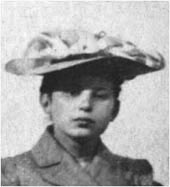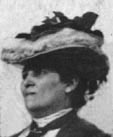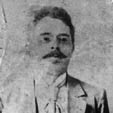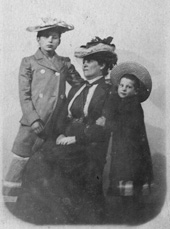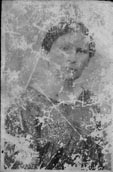| ||||
|
|
||||
Sabina ca. 1901
Mother
Father
Sabina, Mother, Emilia
Sabina, last picture
“Über den psychologischen Inhalt eines Falles von Schizophrenie (Dementia Praecox).” Jahrbuch für psychoanalytische und psychopathologische Forschungen (1912): 3:329–400; “Die Destruktion als Ursache des Werdens.” Jahrbuch für psychoanalytische und psychopathologische Forschungen (1912) 4:465–503; “Beiträge zur Kenntnis der kindlichen Seele.” Zentralblatt für Psychoanalyse und Psychotherapie (1912) 3:57–72; “Mutterliebe.” Imago (1913) 2:523–24; “Selbstbefriedigung in Fusssymbolik.” Zentralblatt für Psychoanalyse und Psychotherapie (1913) 3:263; “Traum vom Vater Freudenreich.” Internationale Zeitschrift für ärztliche Psychotherapie (1913) 1:484–486; “Das unbewusste Träumen in Kuprins Zweikampf.” Imago (1913) 2:524–525; “Die Schwiegermutter.” Imago (1913) 2:589–591: “Der vergessene Name.” Internationale Zeitschrift für ärztliche Psychoanalyse (1914) 2:383–384; “Tiersymbolik und Phobie bei einem Knaben.” Internationale Zeitschrift für ärztliche Psychoanalyse (1914) 2:375–377; “Zwei Mensesträume.” Internationale Zeitschrift für ärztliche Psychoanalyse (1914) 2:32–34; “Ein unbewusster Richterspruch.” Internationale Zeitschrift für ärztliche Psychoanalyse (1915) 3:350; “Die Äusserungen des Oedipuskomplexes im Kindersalter.” Internationale Zeitschrift für ärztliche Psychoanalyse (1916) 1:44–48; “Das Schamgefühl bei Kindern.”Internationale Zeitschrift für ärztliche Psychoanalyse (1920) 6:157–158; “Zur Frage der Entstehung und Entwicklung der Lautsprache.” Internationale Zeitschrift für ärztliche Psychoanalyse (1920) 6:401; “Das schwache Weib.” Internationale Zeitschrift für ärztliche Psychoanalyse (1920) 6:158; “Verdrängte Munderotik.” Internationale Zeitschrift für ärztliche Psychoanalyse (1920) 6:361–362; “Renatchens Menschenentstehungstheorie.” Internationale Zeitschrift für ärztliche Psychoanalyse (1920) 6:155–157; “Russische Literatur.” Bericht über die Fortschritte der Psychoanalyse 1914–1919, Vienna: Internationaler Psychoanalytischer Verlag (1921); “Schnellanalyse einer kindlichen Phobie.” Internationale Zeitschrift für ärztliche Psychoanalyse (1921) 7:473–474; “Briefmarkentraum.” Internationale Zeitschrift für ärztliche Psychoanalyse, (1922) 8:342–343; “Qui est l’auteur du crime?” Journal de Geneve 2 (January 15, 1922); “Die Entstehung der kindlichen Worte Papa und Mama.” Imago (1922) 8:345–367; “Schweiz.” Internationale Zeitschrift für ärztliche Psychoanalyse (1922) 8:234–235; “Rêve et vision des étoiles filantes.” International Journal of Psycho-Analysis (1923) 4:129–132; “Die drei Fragen.” Imago (1923) 9:260–263; “L’automobile: Symbole de la puissance male.” International Journal of Psycho-Analysis (1923) 4:128; “Ein Zuschauertypus.” Internationale Zeitschrift für ärztliche Psychoanalyse (1923) 9:210–211; “Quelques analogies entre la pensée de l’enfant, celle de l’aphasique et la pensée subconsciente.” Archives de psychologie (1923) 18:306–322; “Die Zeit im unterschwelligen Seelenleben.” Imago (1923) 9:300–317; “Einige kleine Mitteilungen aus dem Kinderleben.” Zeitschrift für Psychoanalytische Pädagogik (1927/28) 2:95–99; “Kinderzeichnungen bei offenen und geschlossenen Augen.” Imago (1931) 16:259–291; |
LIFE AND WORKS
1885Sabina Spielrein was born on November 7, in Rostov on Don in Russia, as the eldest daughter of the wealthy Jewish businessman Nikolai Spielrein and his wife Eva. 1887Brother Jan was born. 1891Brother Isaak was born. 1895Sister Emilia (Milotschka) was born. 1899Brother Emil was born. 1901Emilia, her beloved little sister, died of typhoid fever. 1904Her parents sent Sabina to Switzerland for therapy of nervous symptoms. After a short stay in the Heller Sanatorium in Interlaken she was transferred to the Burghölzli mental hospital and treated by C.G. Jung with Freud's new method: Psychoanalysis. Jung´s diagnose: hysteria. 1905Sabina was released from the hospital in June and began to study medicine at the University of Zurich. She remained Jung's analysis patient until 1910. 1906Jung and Freud began their mail correspondance about Sabina Spielrein. 1911Sabina obtained her doctorate with her study "Concerning the Psychological Content of a Case of Schizophrenia" that was published as the lead paper in the "Jahrbuch für psychoanalytische und psychopathologische Forschungen ". She moved to Vienna and became a member of Freud's "Vienna Psychoanalytical Society". 1912Her work " Destruction as Cause of Coming into Being" was published in the "Jahrbuch für psychoanalytische und psychopathologische Forschungen". 1913Sabina and Pavel lived in Berlin and their daughter Renata was born. Sabina wrote several papers. 1914At the begin of World War II, Pawel Scheftel returned to Russia and Sabina moved to Switzerland with the child. 1917Sabina lived with Renata in Lausanne and worked in a surgical clinic. 1920At the 6th International Psychoanalytical Congress in The Hague, she gave a lecture entitled "About the Origin and Development of Articulation". 1921In Geneva she worked at the Jean-Jacques Rousseau Institute on child psychology and published several articles. Among her analysands was the young Jean Piaget. 1922Sabina´s mother died. 1923Sabina Spielrein returned to Russia and worked in Moscow at the 'Russian Psychoanalytical Institute, the 'Psychoanalytical Home for Children' and at the 'Department of Child Psychology' at the 'First University of Moscow'. 1924After Stalins reprisals against Psychoanalytical Institutions she moved to Rostov, her hometown and reunited with her husband. 1926Birth of her secound daughter Eva. 1933Psychoanalysis was prohibited by Stalin. 1935-38Sabina's brothers were deported and executed 1937Her husband died of heart failure. 1938her father died of grief. 1942In August, Sabina and her two daughters were executed by the Nazis outside of Rostov, together with many other Jews.
|
|||
